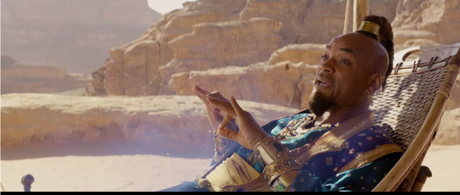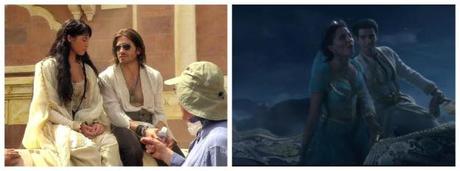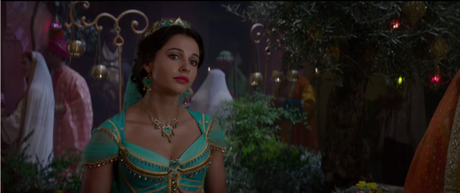Congratulations, internet, yourhorrified Aladdin memes shamed Disney into fast-tracking a brand new trailer showing Will Smith won't actually be blue for the whole movie. In fact, outside of that first scene in the cave he'll mostly just look like Will Smith in, let's say, a Bollywood movie.

With that bit of business out of the way, the new trailer does the Disney live-action remake thing: slavishly recreate the original and hit some of the nostalgic high points with songs like "Friend Like Me" and "A Whole New World."
If past is any indication, once this Aladdin arrives it will likely include just enough in the way of modernization to seem worthy of praise to some, ala the subtle updates the recent Beauty and the Beast gave to Belle's character arc. At the same time, however, it will likely lack enough genuinely new material to quiet the cynics who wonder why the movie even needs to exist at all.
To the cynics, don't just give them "Alan Menken wrote a couple of new songs to hopefully win an Oscar" or "Will Smith as the genie!" either. Sure, dude's charming, but we ain't exactly getting him at the peak of his career whereas the 1992 version has Robin Williams in his prime.
But apart from that increasingly familiar argument between fan and cynic, there is something this new Aladdin has to offer that does stand out as unique in the current Hollywood blockbuster playing field: two Arab stars.
Just watch the trailer and think of the last time you saw a movie with two leads - Jasmine and Aladdin, not the Genie - who look like that:
The last time Disney played in this vaguely similar arena, they cast a white, California dude of Swedish descent to play a Persian street urchin turned prince and a white girl from the UK to play his princess. Yes, I'm talking about Prince of Persia, a movie time - and Disney - has mostly forgotten.

That was just 9 years ago, a time when such casting decisions were made on box office appeal. Disney has since rightly concluded their brand is almost enough to entirely sell itself. Combine that with Aladdin nostalgia and you can make the financial gamble of delivering a more accurately-cast remake whose only name actor is the Genie.
Outside of Disney faithful, no one remembers two white people voiced Aladdin and Jasmine in the old movie. It's harder to hide them like that in a live-action setting. So, we're now looking at an Aladdin and Jasmine we probably don't recognize. Mena Massoud, an Egyptian-born actor who grew up in Canada and played small roles for a half-decade before being cast as Aladdin, and Naomi Scott, our new Jasmine, aren't exactly household names.
Well, Naomi might be, depending on the household. Born to an Indian mother and English father and raised in London, Naomi actually has quite a few notable credits to her name already, including starring roles on the TV shows Life Bites and Terra Nova and a co-starring role as the Pink Ranger in last year's Power Rangers movie. This year, after she debuts as the new Jasmine she'll also pop up as one of the Angels in the Elizabeth Banks-directed Charlie's Angels reboot movie.
So, she's had quite the career already, but playing Jasmine in Aladdin is clearly a new apex moment for her. It doesn't come without its own controversy, though.

Disney quite publicly conducted a worldwide casting search with the expressed aim of ensuring the lead Aladdin roles would be of Middle Eastern and/or South Asian backgrounds. (A similar stab at authenticity occurred for their still-gestating Mulan remake.) After looking for 6 months and journeying to 15 different countries, Disney and director Guy Ritchie ended up with a dude from Canada and a girl from London. Seems like a lot of work for pretty ordinary-by-Hollywood-standards results. Aladdin and Jasmine, however, went to working actors who had long since emigrated West or weren't actually born there in the first place.
That struck some as odd. However, expecting Disney to not only cast actors of the right ethnicity but also those who actually live in the region is a tad much. Since Massoud is Egyptian, his casting mostly went by without pushback. Scott, a half-Indian, half-English, actress playing Jasmine didn't go over so easily.
Disney dispatched its Vice President of Multicultural Engagement, a job title most probably don't know actually exists, to Entertainment Weekly to explain things. I cede the floor to Julie Ann Crommett:
Given the first animated movie and the origins of the story in terms of the entire history of the text and story of Aladdin, it very much reflects a mixing or association of different cultures in a broad region that you can consider the Middle East slash South Asia and even to China actually by extension, so really the Silk Road. There was a real intention for Agrabah to become the center of the Silk Road and reflect the diversity and movement of what we can loosely construe that time period to have been, which was a golden age as well for the region.
I think you'll see, not only the principle cast but also in the background, a city that reflects the extended regions. I think what's interesting about Naomi was that - and we had a deep conversation about it - there are South Asian individuals who associate with Aladdin and with Jasmine as well, and I think there was a sense of we should reflect some part of the community in the principle cast so that we're actually being inclusive of who sees themselves and identifies with this text...What we've done intentionally with Naomi's character as part of the plot is that her mother is actually from a different land, and it's very clear in the movie that her mother is from a different land that's not Agrabah and that's drawing on a lot of her motivations in terms of how she sees the future of Agrabah as a welcoming place that embraces people from other places because her mother was from somewhere else.
In that same interview, Crommett addresses other points of concern.
- Why did you entrust this to a primarily white group of filmmakers? As we did on Moana and Coco, we hired cultural consultants to help them, is the gist of her answer.
- How are you going to address the cultural insensitivities and inaccuracies present in the 1992 original? "Iconography that's in the first movie like swords, a removal of sword iconography that somehow that goes immediately to violence. There is a move away from what feels like stereotypes in terms of portrayals and characterizations very deeply - Jasmine's character arc is one that is very empowered and not based around the idea of marriage."
That wasn't even the end of it for the controversies. When, for example, Disney painted the skin colors of white stunt performers brown, people got upset. Billy Magnussen's addition to the cast as a newly-created-for-the-movie character who might compete against Aladdin for Jasmine struck others the wrong way.
Big picture it for me: Making a movie about characters from a fictional Middle Eastern/South Asian hybrid city in 1992 vs. doing the same in 2019? A whole new world. (Sorry. I just couldn't help myself.)
But even in the Prince of Persia vs. Aladdin example, we see it's a whole new world than it was just a decade ago. The goal is to get it right and give people of color characters who look like them, but when you're dealing with so many affected countries and nationalities there's a much higher chance of offending. It's so much easier when everyone is just making jokes about Will Smith's weird blue skin.
Aladdin is due May 24th.
Grew up obsessing over movies and TV shows. Worked in a video store. Minored in film at college because my college didn't offer a film major. Worked in academia for a while. Have been freelance writing and running this blog since 2013. View all posts by Kelly Konda

